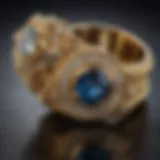Exploring the Allure of 10 Carat Yellow Diamonds
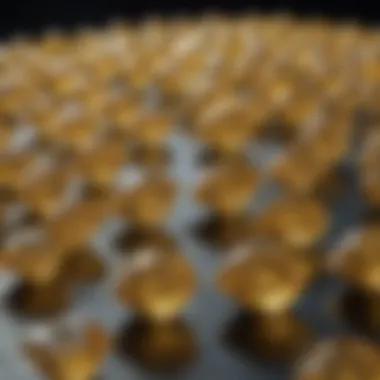

Intro
Yellow diamonds, particularly those weighing in at ten carats, hold a certain mystique in the world of gemstones. Their hue, a captivating blend of warmth and vibrancy, challenges conventional ideas of beauty while offering a rich tapestry of history, science, and cultural significance. As we journey into this article, we will explore the inner workings of these remarkable gems, examining their properties, market dynamics, and care needs. Each aspect not only highlights the allure of ten carat yellow diamonds but also their position as coveted items for collectors and jewelry designers alike.
Overview of Gemstones and Minerals
Understanding yellow diamonds begins with a broader knowledge of gemstones and minerals. These beautiful creations of nature have graced the Earth for millennia, capturing human interest and inspiring artistry.
History of Gemstone and Mineral Use
Throughout history, gemstones have been woven into the fabric of human culture and society. From ancient Egyptians adorning themselves with lapis lazuli to the crowns of European monarchs glimmering with sapphires, gemstones symbolize wealth, power, and timeless beauty. This fascination with gemstones isn't merely aesthetic; it has deep roots in tradition and belief.
Significance in Culture and Society
Yellow diamonds hold a unique place in this historical narrative. The color yellow has often been associated with joy, abundance, and prosperity across various cultures. In some traditions, yellow stones were believed to harness sunlight, representing vitality and energy.
Gemstone Formation and Properties
Delving deeper, let’s unravel the essence of how gemstones, particularly yellow diamonds, are formed and what properties distinguish them.
Formation Process of Gemstones
Diamonds form under extreme heat and pressure deep within the Earth’s mantle over millions of years. The journey to the surface, often through volcanic eruptions, and the process of crystallization results in stunning gems that sparkle with brilliance.
Properties that Define Gemstones
The unique attributes of gemstones are what make them truly special. For yellow diamonds, the following properties are crucial:
- Color: Ranging from light canary to deep mustard, the variation offers uniqueness that appeals to collectors.
- Hardness: Scoring a 10 on the Mohs scale, diamonds are the hardest known natural material, making them durable.
- Clarity: Yellow diamonds can exhibit inclusions, but higher clarity often leads to greater value.
Classification based on Color, Hardness, and Luster
Classifying gems involves understanding their color spectrum, hardness, and luster. Yellow diamonds, with their rich hues and brilliant luster, are often sought after for their substantial aesthetic appeal.
Types of Gemstones
The world of gemstones is vast, and they can be broadly categorized into different types. Understanding these types helps in appreciating yellow diamonds better.
Precious vs. Semi-Precious Gemstones
Emerging from this classification, we find that yellow diamonds are considered precious gemstones, along with rubies, sapphires, and emeralds. Their rarity contributes significantly to their esteemed status in the jewelry realm.
Common Gemstone Varieties
Some common varieties of gemstones include:
- Diamonds (including yellow)
- Emeralds
- Sapphires
- Rubies
Exotic and Rare Gemstones
While many gems are sought after, rare varieties like pink diamonds or even green diamonds excite gem enthusiasts. Yellow diamonds, especially in larger carat weights, share this rarefied breath with the exotic.
Identifying and Evaluating Gemstones
Assessing the value and authenticity of gemstones requires both skill and an understanding of key factors.
Factors Affecting Gemstone Value
Several determinants influence a yellow diamond’s price, including:
- Carat weight (in this case, ten carats)
- Color intensity and hue
- Clarity and overall condition
Techniques for Gemstone Identification
Gemologists employ various methods to identify and evaluate gemstones, including:
- Microscopic examination to identify inclusions
- Spectroscopic analysis for color grading
- Refractive index measurement for authenticity check
Assessing Gemstone Quality
When evaluating the quality, color, clarity, and cut are paramount. The most prized yellow diamonds flaunt deep, vivid colors with minimal inclusions.
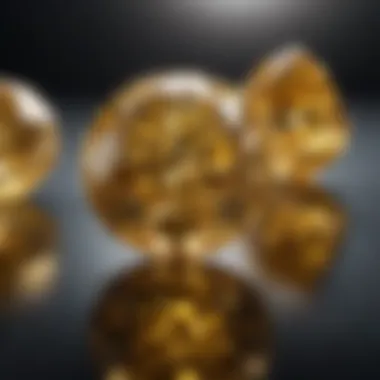

Caring for Gemstones
To maintain the beauty and value of yellow diamonds, proper care is essential.
Cleaning and Storing Gemstones Properly
Cleaning yellow diamonds requires gentle approaches. Use a soft cloth and mild soapy water, avoiding harsh chemicals that could damage the stone over time.
Avoiding Common Mistakes in Gemstone Care
Some frequent missteps include:
- Storing jewelry in damp areas, which can affect the stones.
- Using abrasive cleaners that could scratch the surface.
Preservation Tips for Specific Gem Types
Particular care might be needed based on the composition of stones. With yellow diamonds, consistent care helps in preserving their brilliance and vibrancy.
"The love for diamonds is often more than just aesthetic; it's an investment in a piece of earth's artistry."
In summation, ten carat yellow diamonds emerge as captivating symbols of elegance, richness, and rarity. They not only tell a story about their geological origins but also about the cultural meanings that surround them in various contexts. Their stewardship transcends mere ownership; it embodies a connection to a legacy that is as rich and layered as the gem itself.
Preface to Yellow Diamonds
Yellow diamonds, often seen as the sun's embrace in the gemstone realm, are not just another pretty face in the world of jewels. These stones hold a unique depth and allure, having carved their niche as symbols of luxury and warmth. The sheer volume of intrigue surrounding them lies not only in their vibrant color but also in the various factors that contribute to their desirability.
Understanding Diamond Color
Color in diamonds is a fascinating topic, as it involves more than just the visible hue that meets the eye. The grading of a diamond's color is a meticulous process influenced by multiple elements, from its chemical composition to the environment in which it formed. Yellow diamonds specifically are colored by the presence of nitrogen atoms within their carbon lattice. When nitrogen atoms bond in pairs, they absorb blue light, thus giving the diamonds their characteristic yellow hue.
It's important to note that the depth and tone of this yellow can vary significantly, leading to a spectrum of shades from pale lemonade to deep canary. Each shade brings its own charm and personality, appealing to different tastes. This range makes selecting the perfect yellow diamond a rewarding experience. Collectors and buyers often emphasize vivid yellows because they stand out more prominently.
The Significance of Carat Weight
When we talk about carat weight, it’s common to think it merely defines the size of a stone. But for yellow diamonds, carat weight plays an even deeper role, specifically in relation to value and appearance. A 10 carat yellow diamond stands as a significant investment. As carat weight increases, rarity escalates, which in turn drives market prices up.
Larger diamonds capture the light differently, creating a more striking visual impact. This is particularly true for diamonds graded in the Fancy color categories; here, the larger the stone, the more pronounced its hue appears.
In essence, carat weight is not just a number. For enthusiasts, it represents a tangible investment, a statement piece of jewelry that makes a significant mark, both visually and financially. Moreover, buyers often consider this alongside other factors like clarity and cut, as they all interplay to create the ultimate value of the gemstone.
Understanding both color and carat weight is paramount for anyone investing in or collecting yellow diamonds. These elements together help to define what makes each stone unique.
What Constitutes a Carat Yellow Diamond
When we talk about a 10 carat yellow diamond, we're not just dishing out numbers. The weight, clarity, and cut of these gems play a huge role in their overall value and appeal. Each stone is a unique masterpiece enshrined in its own category of rarity and elegance. Understanding these elements is crucial for gemstone enthusiasts, collectors, and anyone who appreciates fine jewelry. Let’s break down the finer aspects that contribute to the allure of this vibrant gemstone.
Defining the Carat
Carat weight is arguably the most straightforward aspect to grasp when evaluating yellow diamonds. One carat is equivalent to 0.2 grams, and in the diamond world, size matters—not just for appearance but also for the pricing. A diamond weighing 10 carats is significantly rare, as the larger the stone, the fewer there are available. Because of this scarcity, the value skyrockets.
But the significance of carat weight extends beyond mere size. Larger diamonds, especially those in the yellow hue spectrum, often exhibit more vibrant colors. An exquisite 10 carat stone can sparkle like a ray of sunshine, making it an eye-catching centerpiece in any collection. Jewelers often emphasize that a well-cut diamond of this size can command gazes from across the room, thanks to its substantial physical presence.
Gemstone Clarity and Its Importance
Clarity refers to the absence of inclusions and blemishes in a diamond. For a 10 carat yellow diamond, clarity ranks high on the list of priorities, as even minor imperfections can significantly impact its overall aesthetics and value. Clarity grading ranges from Flawless (no inclusions visible under 10x magnification) to Included (inclusions visible to the naked eye).
For instance, a clarity grade of VS1 or VS2 (Very Slightly Included) would typically be more appealing than one with visible inclusions. Collectors often seek diamonds that pack a punch in both size and clarity. The clearer, the better; a spotless yellow diamond allows the color to emanate beautifully, often resulting in a more dazzling appearance.
Cut Quality and Its Influence on Appearance
Cut quality is where the magic really happens. Regardless of a diamond’s size, its cut determines how much light dances off its facets—this is what ultimately gives a diamond its brilliance. The term "cut" doesn’t merely refer to the shape of the diamond; it encompasses the proportions, symmetry, and polish. For a diamond as sizeable as 10 carats, a superior cut becomes even more critical.
A well-cut 10 carat yellow diamond can radiate vibrant colors, enhancing its natural beauty and making it appear lively. Alternatively, an inferior cut can lead to a dull appearance, even for larger stones, due to improper light reflection. Thus, the cut quality not only influences the overall visual appearance but also plays a role in its market value.
"In the gemstone world, the beauty of a diamond is defined more by how effectively it interacts with light than merely its size itself."
In summary, the intricacies behind a 10 carat yellow diamond go beyond surface-level aesthetics. The confluence of carat weight, clarity, and cut quality defines its desirability and value, making it a treasure for collectors and enthusiasts alike. Each element must be considered carefully when estimating the worth and visual appeal of such a gemstone.
The Science of Color in Diamonds
Understanding the science behind diamond coloration is a crucial aspect when diving into the world of yellow diamonds, particularly those of 10 carats. Color in diamonds goes beyond mere aesthetics; it embodies a complex interplay of light, structure, and elemental impurities. As such, the study of diamond color not only enriches our appreciation of these gems but also equips collectors and enthusiasts with valuable insights into their quality and value.
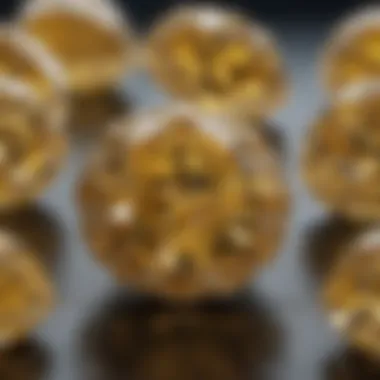

Mechanism of Yellow Color Formation
Yellow diamonds get their distinctive hue primarily from the presence of nitrogen atoms within their crystal lattice. When these nitrogen atoms absorb light, they can cause the diamond to reflect yellow tones, thus giving rise to its name. The color intensity can vary significantly; some yellow diamonds display a muted, delicate shade, while others shine with a vibrant, deep yellow hue.
The specific arrangement of nitrogen atoms plays a pivotal role here. In some instances, two or more nitrogen atoms share nearby lattice sites, amplifying the yellow effect. This phenomenon is why some diamonds are more vibrant than others. The interplay between light and these atomic structures determines how the diamond reflects and refracts incoming light, creating the captivating sparkles we admire.
It's worth noting that the saturation and tone of yellow in diamonds are evaluated based on professional grading standards. Factors like hue—ranging from light yellow to fancy vivid—are instrumental in determining value. Collectors aspiring to own a standout piece should pay close attention to these grading aspects when selecting their 10 carat yellow diamond.
Impact of Natural vs. Synthetic Treatment
The rise of synthetic diamonds has become a game changer in the modern gem market. While natural yellow diamonds are mined from the earth and possess unique geological histories, synthetic yellow diamonds are cultured in laboratories under controlled conditions. Both types exhibit similar aesthetic qualities, but their origins can significantly affect their market value and perception.
Natural yellow diamonds are often considered prized trophies, given their rarity and the narrative of their formation over billions of years. However, synthetic diamonds have their own appeal, particularly for those looking for a more cost-effective solution without sacrificing appearance. Commonly marketed as “lab-created,” these diamonds can be nearly indistinguishable from their natural counterparts without the aid of specialized equipment.
In the context of investment, natural stones typically command higher prices due to their scarcity and historical significance. Furthermore, the market is increasingly leaning towards transparency—hence, buyers should be meticulous about understanding the origins of their diamonds. Knowing whether a diamond has been treated or is completely natural can sway buying decisions, influencing both emotional and financial investment.
"Why settle for imitation when you can own a piece of history? Natural diamonds tell a story that technology can't replicate."
By recognizing the differences and implications of natural versus synthetic yellow diamonds, potential buyers garner invaluable guidance in navigating the intricate gemstone landscape.
Market Dynamics of Yellow Diamonds
Understanding the market dynamics of yellow diamonds is essential for any enthusiast or investor. The interplay of demand, supply, and cultural perceptions in the gemstone landscape creates a unique ecosystem that dictates not just the prices but also the desirability of these stones. Analyzing how these factors come into play can enrich one’s comprehension of yellow diamonds and potentially guide purchasing decisions.
Current Trends in the Market
Recent years have seen a marked shift in consumer preferences. Yellow diamonds, long cherished for their rarity, have been finding a larger audience due to increased exposure in mainstream media and high-profile celebrity endorsements.
- Social Media Influence: Platforms like Instagram have catalyzed visibility, showcasing the beauty of these gems in ways that traditional advertising never could.
- Celebrity Ownership: The visibility provided by stars like Beyonce, who sported a massive yellow diamond ring, has piqued interest.
A noticeable fluctuation in market trends is also driven by gemstone auctions. The prices of certain high-quality yellow diamonds have soared while others have plateaued, indicating a bifurcation in buyer interest based on quality and provenance.
Investment Potential of Yellow Diamonds
Investing in yellow diamonds is emerging as an interesting avenue for collectors and investors alike. Their rarity, combined with growing celebrity interest and public exposure, positions them as viable assets in a portfolio.
Some key aspects to consider:
- Long-Term Value: Historically, colored diamonds, particularly yellow ones, have appreciated significantly in value. While the market does experience fluctuations, many experts cite ongoing demand as a driving force.
- Limited Supply: Unlike traditional diamonds, yellow diamonds have a limited supply, especially in larger carat weights. This scarcity can precipitate value increases over time.
- Diverse Market Base: Yellow diamonds appeal both to end consumers and investors, creating a broader market foundation. This dual appeal enhances stability within the market.
"Investing in yellow diamonds is not just about owning a piece of jewelry; it’s about securing a part of a prosperous investment journey."
Comparative Analysis with Other Colored Diamonds
When considering colored diamonds, yellow diamonds often find themselves compared to other notable hues, such as pink, blue, or green. Each color possesses unique attributes and market appeal.
- Yellow vs. Pink Diamonds: Pink diamonds can fetch far higher prices, often due to their extreme rarity. However, the growing interest in yellow diamonds is creating a more competitive market.
- Yellow vs. Blue Diamonds: Blue diamonds, such as the famous Hope Diamond, typically dominate the headlines and auction houses; still, yellow diamonds are gaining ground in desirability due to their noticeably vibrant colors and typically lower price point.
- Market Movement: While investment in colored diamonds can be speculative, yellow diamonds present a more stable path for collectors and investors due to increasing demand and market diversification.
In summary, yellow diamonds are not just beautiful gems; they embody a complex market influenced by trends, investment opportunities, and comparisons with their colored cousins. Understanding these dynamics aids consumers and investors in navigating their decisions with confidence.
Cultural Importance of Yellow Diamonds
Yellow diamonds, with their distinctive hue, have held a significant place in various cultures and societies throughout history. They are not just pieces of jewelry but also symbols laden with meaning. Their unique color and perceived rarity contribute to their cultural relevance, influencing fashion, art, and even social status.
Historical Significance in Society
The journey of yellow diamonds in history is fascinating. These gems date back centuries, with ancient civilizations recognizing their beauty and value. For instance, kings and queens adorned themselves with yellow diamonds, believing that such opulence reflected their divine right to rule and brought them good fortune. One famous example lies with the historic "canary yellow diamond," treasured by royalty and often regarded as a symbol of power and wealth.
In various regions, yellow diamonds were often associated with warmth and happiness. In many cultures, they are thought to represent prosperity and abundance. The ancient Romans even regarded yellow diamonds as a source of energy, believing they unleashed positive forces when set in jewelry.
Yellow Diamonds in Popular Culture
In modern times, yellow diamonds have carved a niche in popular culture as well. They frequently appear in films, television, and celebrity jewelry collections, often representing luxury and modern elegance. Celebrities like Jennifer Lopez and Halle Berry have been seen wearing stunning yellow diamond rings, making them a trending choice for engagement rings.
They've also found their place in art. Numerous artists, inspired by their striking color, have incorporated yellow diamonds in their work, enhancing the visual narrative with the gem's captivating glow.
Moreover, the popularity of yellow diamonds remains robust in social media platforms. Instagram accounts dedicated to luxury and fashion often showcase how these gems can elevate an ensemble. From red carpets to jewelry exhibitions, yellow diamonds are positioned as both an aesthetic choice and a statement of individuality.
"Yellow diamonds serve not just as an ornament, but as a narrative of one’s aspirations and lifestyle."
Such factors contribute to the cultural tapestry associated with yellow diamonds, emphasizing that they are anything but ordinary. The inclination towards these stones can be observed as a shift in aesthetic preferences, signaling a desire for uniqueness and connection to the past.
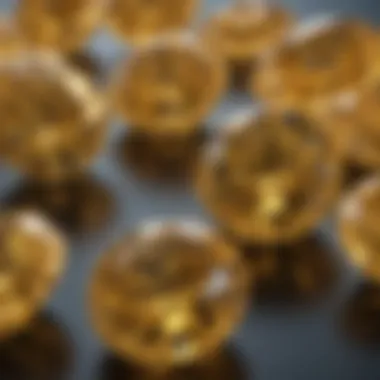

Finale
With a foundation intertwined through history and a strong presence in contemporary culture, the cultural significance of yellow diamonds extends far beyond their physical allure. They encapsulate stories of fortune, prestige, and individual expression, which further enriches their value in today’s jewelry landscape.
Care and Maintenance of Carat Yellow Diamonds
Taking care of your 10 carat yellow diamond isn't just about keeping it shining—it’s also about preserving its intrinsic value and beauty. These gems, much like fine art or vintage cars, require a certain level of respect and knowledge to maintain. The unique characteristics of yellow diamonds do demand specific care protocols that set them apart from regular diamonds, ensuring that they remain both visually striking and investment worthy.
Cleaning Recommendations
When it comes to cleaning your yellow diamond, the smoother the surface, the better the sparkle. It is generally suggested to clean them regularly but gently. Here’s how:
- Use a Soft Cloth: A clean, lint-free cloth to remove any dust or oils. Make sure it is microfiber, as normal cloth might scratch the surface.
- Mild Soap Solution: Mix a few drops of dish soap with warm water. Soak the diamond for about 20 to 30 minutes before gently scrubbing with a soft brush. Avoid harsh chemicals like bleach or ammonia.
- Rinse Well: After cleaning, rinse the diamond thoroughly with clean water to ensure no soap residue is left, which might dull its shine.
- Dry Carefully: Use a soft cloth to pat dry, making sure to get into the crevices where dirt may hide.
"Regular cleaning not only enhances the diamond's brilliance but also gives you a chance to catch any issues like loose settings before they become bigger problems."
Storage Best Practices
When storing your yellow diamond, consider both the physical environment and its surrounding companions. Protecting it from scratches and environmental factors is essential:
- Individual Pouches: Store each diamond in its own soft pouch to prevent scratching against other gemstones or metals.
- Safe Location: Choose a cool, dry place away from direct sunlight, as prolonged exposure can affect the diamond's color.
- Jewelry Box with Dividers: If you use a jewelry box, ensure it has soft lining and compartments to keep pieces separated.
- Avoid Humidity: Excess humidity can lead to tarnishing of the metal setting or other damage. Using silica gel packs in storage areas can help maintain the right environment.
Signs of Damage and Repair Solutions
Knowing the signs of damage to your diamond is critical for preservation. If you spot any of these indicators, it may be time for a professional inspection:
- Loose Stones: If you notice any slight movement when you try to shift the diamond in its setting, it’s a sign that the setting may be damaged.
- Scratches or Chips: Look for any visual imperfections on the surface of the diamond that weren’t there before.
- Dullness: If the diamond seems less bright than when you first acquired it, that may indicate that it needs a professional cleaning or even a re-polish.
For repairs, it’s essential to consult professionals who specialize in high-value gems. They can re-secure loose settings or polish stones without causing further damage. In matters of jewelry restoration, always opt for trusted jewelers who have proven experience with colored diamonds specifically.
Keeping your 10 carat yellow diamond in prime condition might seem like an added chore, but the reward of maintaining its beauty and value is incredibly worthwhile. After all, this gem is not just a piece of jewelry, but a treasured asset.
Preservation requires knowledge, proper cleaning, and diligent storage to ensure the brilliance and allure of these magnificent stones remains intact long into the future.
Choosing the Right Setting for Yellow Diamonds
Selecting the right setting for a 10 carat yellow diamond is not merely about aesthetics; it is critical for enhancing the gem’s unique properties and securing its safety. The setting you choose can dramatically affect the overall appearance of the diamond and influence how the light interacts with it. Each design element works to enhance the stone’s glorious color and brilliance. Let's delve deeper into this topic, exploring its significance, and what makes the perfect setting stand out.
Popular Styles and Designs
The design of a setting plays an essential role in showcasing a yellow diamond’s vivid hue. Here are some popular options:
- Solitaire Settings: A classic solitaire ring emphasizes the diamond itself without distractions. Its simple band allows the rich yellow color to take center stage.
- Halo Settings: This design features a circle of smaller diamonds surrounding the yellow diamond, creating a stunning contrast. The smaller stones can enhance the sense of size and brilliance, making the yellow diamond appear even more striking.
- Three-Stone Settings: Also known as a trinity setting, it features three stones that can symbolize the past, present, and future. It offers plenty of versatility in choosing complementary stones that can add depths to the overall design.
- Vintage Settings: These designs often include intricate details and filigree, celebrating the unique characteristics of a yellow diamond. Vintage styles are compelling for those who appreciate history and artistry in jewelry.
Choosing the right style ultimately depends on personal taste, desired symbolism, and of course, how well it brings out the beauty of the yellow diamond.
Metal Options and Their Complementarity
The choice of metal for the setting is also paramount. Each type of metal interacts with the diamond color in different ways, enhancing or sometimes muting its brightness. Here’s a look at popular metal options:
- White Gold: This modern metal can create a striking contrast with a yellow diamond, emphasizing its color while providing a sleek, contemporary feel.
- Yellow Gold: This option can enhance the warmth of the diamond, creating a cohesive look that embraces the stone’s natural hue. Yellow gold settings can also provide a vintage vibe, which many collectors find appealing.
- Rose Gold: Known for its romantic hue, rose gold settings offer a beautiful backdrop for yellow diamonds, creating a softer and more delicate appearance.
- Platinum: As a durable and hypoallergenic option, platinum also enhances a diamond's brilliance. However, its cool tone may not suit everyone's style preference.
When selecting the right setting, it's not just about the diamond's size, clarity or cut—consideration of style, design, and metal choice can greatly impact not just the diamond's appearance but also the emotional connection one might have with the piece.
"A setting should complement, not compete with, the unique beauty of a yellow diamond."
The right choice will surely forge a lasting connection between the owner and the beauty of their 10 carat yellow diamond, making it feel like an integral part of their own story.
The End
When it comes to 10 carat yellow diamonds, this article has shed light on the various intricacies that make these gemstones so attractive. The discussion ranges from their unique visual characteristics to the factors that determine their market appeal. There is much more than meets the eye with these gems, and understanding them requires attention to multiple intricate factors.
The Enduring Allure of Yellow Diamonds
Yellow diamonds captivate us with their warm hues, often reminiscent of sunlight filtering through gentle leaves. Their enduring appeal can be attributed not only to their intrinsic beauty but also to their symbolism. These stones often represent joy and optimism, making them a charming choice for significant life events such as engagements and anniversaries.
The rarity of a 10 carat yellow diamond in this shade of color adds to its allure. While diamonds typically fall into a colorless category, those with distinct yellow tones blend beauty with a sense of individuality. As gemstone enthusiasts can attest, finding a stone that possesses both size and rich color is no small feat.
Moreover, the fascinating stories behind each stone, from their formation deep within the Earth to their eventual discovery, create a narrative that many collectors value highly. The cultural significance, often highlighted in films and jewelry showcases, further elevates these gemstones in the eyes of admirers.
Final Words on Investment and Aesthetic Value
Investing in 10 carat yellow diamonds can be equal parts thrilling and daunting. For those who appreciate fine jewelry and the art of gemstone collection, these diamonds represent both beauty and a potential return on investment. The aesthetic value is apparent in their stunning visual display, while their investment potential can offer dividends in the long run.
Factors that influence their market value include clarity, cut, and the vibrancy of color. Buyers and collectors should approach the market with caution, ensuring they do their research to find high-quality stones at fair prices.
Ultimately, yellow diamonds stand out not just for their visual appeal but also for the narratives and meanings that are often interwoven with them. For collectors and enthusiasts alike, understanding the aesthetic importance coupled with market dynamics is crucial when considering these remarkable gems. Their both the beauty and investment potential, making them a truly compelling choice in the realm of fine jewelry.
